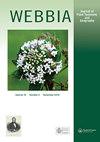Tracking Brazil’s Colonization Footprints: First record of the tea plant (Camellia sinensis (L.) Kuntze – Theaceae) naturalized in the Atlantic Forest Hotspot
Q3 Agricultural and Biological Sciences
引用次数: 0
Abstract
The colonization of Brazil by Portugal left deep marks in Brazil’s current society and economy. The same applies to the country’s biodiversity, with several introduced plants persisting as naturalized or invasive species. Among these, the tea plant, Camellia sinensis, is a notable case. The species was first cultivated in Rio de Janeiro state during the 19th century, but the crops were later abandoned mostly due to the presence of parasite fungi in cultivations, so that the species’ cultivation continued in other states only. During recent fieldwork in the Atlantic Forest in the municipality of Petrópolis, Rio de Janeiro state, naturalized individuals of the tea plant were discovered. This finding, alongside ecological evidence, highlights a new threat to the biodiversity of an area of high species endemism. We provide historical information on the introduction of the species in Brazil and discuss the threats it imposes to the flora in a world hotspot. Our finding adds C. sinensis to the list of naturalized plants of Flora do Brasil 2020 and emphasizes the importance of monitoring the invasive potential of the species in the area, given its allelopathic potential on the germination of other species and competition with native plants.追踪巴西的殖民足迹:茶树(Camellia sinensis (L.))的第一个记录在大西洋森林热点地区归化的昆山科植物
葡萄牙对巴西的殖民统治在巴西当前的社会和经济中留下了深刻的印记。这同样适用于该国的生物多样性,一些引入的植物作为归化或入侵物种持续存在。其中,茶树茶花就是一个显著的例子。19世纪,该物种首次在里约热内卢州种植,但后来由于种植过程中存在寄生真菌,作物被废弃,因此该物种的种植只在其他州继续。最近在里约热内卢州彼得罗波利斯市的大西洋森林进行的实地调查中,发现了这种茶树的归化个体。这一发现,加上生态证据,突显了对一个物种特有性高的地区的生物多样性的新威胁。我们提供了该物种在巴西引入的历史信息,并讨论了它对世界热点地区植物群的威胁。我们的发现将中华鳖列入了《巴西植物志2020》的归化植物名单,并强调了监测该物种在该地区入侵潜力的重要性,因为它对其他物种的发芽具有化感潜力,并与本地植物竞争。
本文章由计算机程序翻译,如有差异,请以英文原文为准。
求助全文
约1分钟内获得全文
求助全文

 求助内容:
求助内容: 应助结果提醒方式:
应助结果提醒方式:


